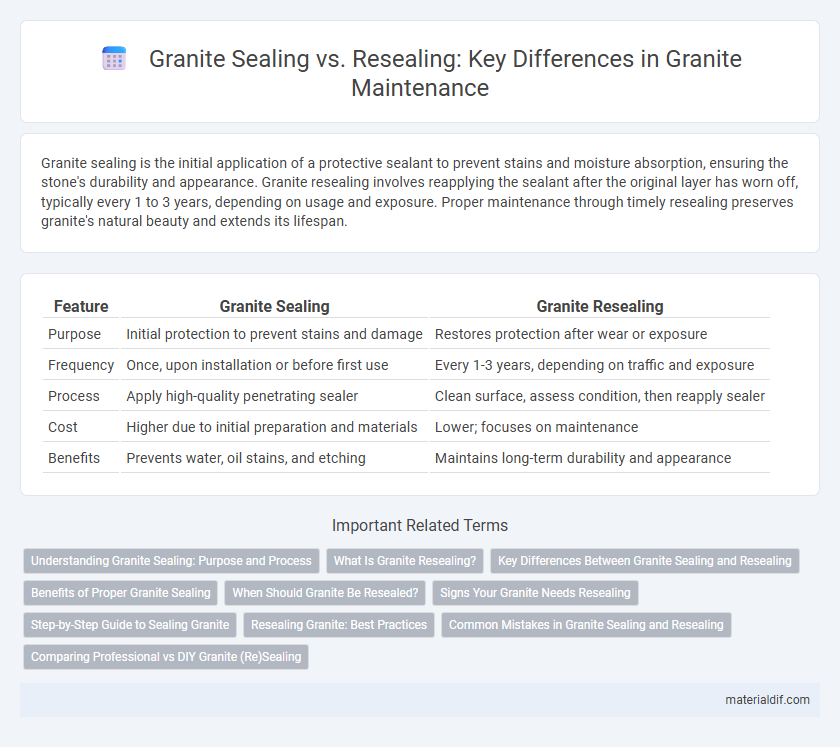Granite sealing is the initial application of a protective sealant to prevent stains and moisture absorption, ensuring the stone's durability and appearance. Granite resealing involves reapplying the sealant after the original layer has worn off, typically every 1 to 3 years, depending on usage and exposure. Proper maintenance through timely resealing preserves granite's natural beauty and extends its lifespan.
Table of Comparison
| Feature | Granite Sealing | Granite Resealing |
|---|---|---|
| Purpose | Initial protection to prevent stains and damage | Restores protection after wear or exposure |
| Frequency | Once, upon installation or before first use | Every 1-3 years, depending on traffic and exposure |
| Process | Apply high-quality penetrating sealer | Clean surface, assess condition, then reapply sealer |
| Cost | Higher due to initial preparation and materials | Lower; focuses on maintenance |
| Benefits | Prevents water, oil stains, and etching | Maintains long-term durability and appearance |
Understanding Granite Sealing: Purpose and Process
Granite sealing involves applying a protective sealant to the stone's surface to prevent stains, moisture, and damage by filling pores and creating a barrier. This process enhances the durability and appearance of granite countertops, flooring, or tiles, preserving their natural beauty and extending their lifespan. Resealing is the subsequent application after the initial sealant wears off, necessary to maintain the stone's protection and prevent deterioration over time.
What Is Granite Resealing?
Granite resealing is the process of applying a new protective sealant to granite surfaces after the original sealant has worn off or degraded over time. This maintenance step restores the granite's resistance to stains, moisture, and damage, ensuring long-term durability and aesthetic appeal. Unlike initial granite sealing, resealing is necessary periodically, typically every one to three years, depending on usage and environmental factors.
Key Differences Between Granite Sealing and Resealing
Granite sealing involves the initial application of a protective sealant to prevent stains and moisture penetration, preserving the stone's natural beauty and durability. Resealing is the subsequent process performed periodically to maintain the sealant's effectiveness, typically every 1 to 3 years depending on usage and exposure. Key differences include the timing of application--sealing is done on new countertops, while resealing is routine maintenance--and the intensity of the treatment, where resealing may involve cleaning and repairing minor surface damage before reapplying the sealant.
Benefits of Proper Granite Sealing
Proper granite sealing protects countertops from stains, moisture, and daily wear, enhancing durability and preserving their natural beauty. Sealing also makes granite surfaces easier to clean and maintain, preventing bacteria buildup in porous areas. Regular resealing ensures ongoing protection, extending the lifespan and aesthetic appeal of granite countertops.
When Should Granite Be Resealed?
Granite should be resealed every 1 to 3 years depending on the level of use and exposure to moisture and stains. To determine if resealing is necessary, perform a water test by placing a few drops of water on the surface; if the water absorbs within 15 minutes, resealing is required to maintain protection. Proper resealing prevents damage, preserves the stone's appearance, and extends the lifespan of granite countertops and surfaces.
Signs Your Granite Needs Resealing
Granite resealing is essential when signs like water beading decrease or dark spots appear, indicating the sealant has worn off. A simple water test revealing absorption or dullness in the stone's surface confirms the need for resealing to maintain its protection and durability. Regularly inspecting your granite countertops for stains, etching, or increased porosity helps ensure timely resealing and preserve their natural beauty.
Step-by-Step Guide to Sealing Granite
Granite sealing involves applying a high-quality penetrating sealer to clean, dry granite surfaces to protect against stains and moisture infiltration. Granite resealing requires repeating this process periodically, typically every 1 to 3 years, depending on usage and sealant wear. A step-by-step guide includes thoroughly cleaning the granite, applying the sealer evenly with a soft cloth or applicator, allowing absorption for 15-20 minutes, and wiping off excess to ensure a durable, glossy finish.
Resealing Granite: Best Practices
Granite resealing involves applying a fresh layer of sealant to restore protection against stains and moisture, typically recommended every 1 to 3 years depending on usage and granite type. Best practices for resealing granite include thoroughly cleaning and drying the surface, conducting a water test to determine sealant efficacy, and using a high-quality, penetrating sealant specifically designed for natural stone. Proper resealing enhances durability, maintains the stone's natural appearance, and prevents costly damage caused by spills and etching.
Common Mistakes in Granite Sealing and Resealing
Common mistakes in granite sealing include applying sealant on wet or dirty surfaces, which prevents proper absorption and reduces effectiveness. During granite resealing, neglecting to strip old sealant residues can cause uneven sealing and diminish protection against stains and moisture. Proper surface preparation and timing are critical to maximize the longevity and durability of granite countertops.
Comparing Professional vs DIY Granite (Re)Sealing
Professional granite sealing ensures a durable, even barrier against stains and moisture by using industrial-grade sealers and precise application techniques, reducing the risk of damage often caused by improper sealing. DIY granite resealing offers cost savings and convenience but may result in inconsistent protection due to inexperienced application and suboptimal product choice. Comparing both methods highlights that professional services maximize granite longevity and aesthetic appeal, while DIY approaches require careful research to achieve effective resealing results.
Granite Sealing vs Granite Resealing Infographic

 materialdif.com
materialdif.com